
The Entolomataceae are a family of fungi in the order Agaricales. The family contains eight genera and 2250 species, the majority of which are in Entoloma. Basidiocarps are typically agaricoid, but a minority are cyphelloid. secotioid, or gasteroid. All produce pink basidiospores that are variously angular (polyhedral), ridged, or nodulose. Species are mostly saprotrophic, though a few are parasitic on other fungi. The family occurs worldwide.

Melanoleuca is a poorly known genus of saprotrophic mushrooms traditionally classified in the family Tricholomataceae. Most are small to medium sized, white, brown, ocher or gray with a cylindrical to subcylindrical stipe and white to pale yellowish gills. The basidiospores are ellipsoid and ornamented with amyloid warts. Melanoleuca is considered a difficult group to study due to their macroscopic similarities among species and the need of a thorough microscopic analysis to separate species. DNA studies have determined that this genus is closely related to Amanita and Pluteus and that it does not belong to the family Tricholomataceae.
Limnoperdon is a fungal genus in the monotypic family Limnoperdaceae. The genus is also monotypic, as it contains a single species, the aquatic fungus Limnoperdon incarnatum. The species, described as new to science in 1976, produces fruit bodies that lack specialized structures such as a stem, cap and gills common in mushrooms. Rather, the fruit bodies—described as aquatic or floating puffballs—are small balls of loosely interwoven hyphae. The balls float on the surface of the water above submerged twigs. Experimental observations on the development of the fruit body, based on the growth on the fungus in pure culture, suggest that a thin strand of mycelium tethers the ball above water while it matures. Fruit bodies start out as a tuft of hyphae, then become cup-shaped, and eventually enclose around a single chamber that contains reddish spores. Initially discovered in a marsh in the state of Washington, the fungus has since been collected in Japan, South Africa, and Canada.

Infundibulicybe is a genus of fungi that is robustly placed incertae sedis as sister group to the Tricholomatoid clade. It has previously been part of the family of Tricholomataceae, but recent molecular phylogeny has shown it to take an isolated position within the Agaricales.

Flammulaster is a genus of agaricoid fungi in the family Tubariaceae. It was formerly thought to belong in the family Inocybaceae. The genus has a widespread distribution, and contains 20 species. Flammulaster was circumscribed by American mycologist Franklin Sumner Earle in 1909.

Phaeomarasmius is a genus of fungi in the family Tubariaceae. It was formerly thought to belong in the family Inocybaceae. The genus has a widespread distribution, and contains about 20 species.

Volvopluteus is a genus of small to medium-sized or big saprotrophic mushrooms growing worldwide. The genus has been segregated from Volvariella with which it shares some morphological characteristics such as the presence of a volva and a pink to pink-brown spore print. Phylogenetic analyses of DNA data have shown that Volvopluteus is closely related to Pluteus and both genera currently are classified in the family Pluteaceae, while Volvariella is not closely related to either genus and its position in the Agaricales is still uncertain.
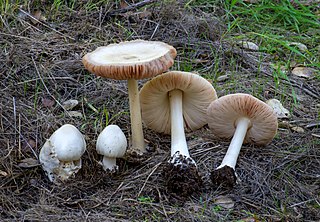
Volvopluteus gloiocephalus, commonly known as the big sheath mushroom, rose-gilled grisette, or stubble rosegill, is a species of mushroom in the family Pluteaceae. For most of the 20th century it has been known under the names Volvariella gloiocephala or Volvariella speciosa, but recent molecular studies have placed it as the type species of the genus Volvopluteus, newly created in 2011. The cap of this mushroom is about 5–15 cm (2–6 in) in diameter, varies from white to grey or grey-brown, and is markedly sticky when fresh. The gills start out as white but they soon turn pink. The stipe is white and has a sack-like volva at the base. Microscopical features and DNA sequence data are of great importance for separating V. gloiocephalus from related species. V. gloiocephalus is a saprotrophic fungus that grows on grassy fields and accumulations of organic matter like compost or woodchips piles. It has been reported from all continents except Antarctica.
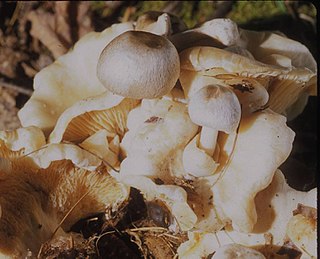
Volvariella surrecta, commonly known as the piggyback rosegill, is an agaric fungus in the family Pluteaceae. Although rare, the species is widely distributed, having been reported from Asia, North America, Northern Africa, Europe, and New Zealand. The fungus grows as a parasite on the fruit bodies of other gilled mushrooms, usually Clitocybe nebularis. V. surrecta mushrooms have white or greyish silky-hairy caps up to 8 cm (3.1 in) in diameter, and white gills that turns pink in maturity. The stipe, also white, is up to 9 cm (3.5 in) long, and has a sack-like volva at its base.

Pluteus nevadensis is a species of fungus in the agaric family Pluteaceae. Described as new to science in 2010, the species is known only from subtropical and pine forests in Mexico, where it grows on rotting pine and oak wood. Fruit bodies (mushrooms) have red-orange caps up to 3.8 cm (1.5 in) in diameter with a shape ranging from conic, convex, or flattened, depending on their age. The silky yellow stems are up to 4.5 cm (1.8 in) long. It is similar in appearance to Pluteus aurantiorugosus, with which it shares an orange- or scarlet-colored cap and a yellow stem. P. nevadensis can be distinguished from this and other superficially similar Pluteus species by differences in microscopic characteristics.
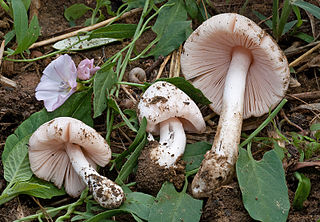
Volvopluteus earlei is a species of mushroom in the family Pluteaceae. It was originally described in 1911 by American mycologist William Alphonso Murrill as Volvariopsis earlei, based on collections made in a Cuban banana field. The fungus was later shuffled to the genera Volvaria and Volvariella before molecular studies placed it in Volvopluteus, a genus newly described in 2011.

Volvopluteus michiganensis is a species of mushroom in the family Pluteaceae. It was originally described under the name Pluteus michiganensis but molecular studies have placed it in the Volvopluteus, a genus described in 2011. The cap of this mushroom is about 7–9 cm (2.8–3.5 in) in diameter, gray, and has a cracked margin that is sticky when fresh. The gills start out as white but they soon turn pink. The stipe is white and has a volva at the base. Microscopical features and DNA sequence data are of great importance for separating this taxon from related species. V. michiganensis is a saprotrophic fungus that was originally described as growing on sawdust. It has only been reported from Michigan (USA) and the Dominican Republic.
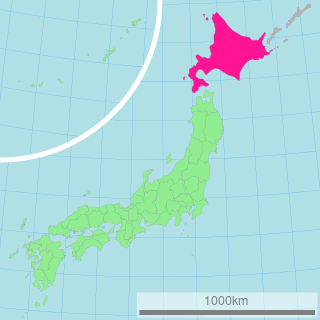
Volvopluteus asiaticus is a species of mushroom in the Pluteaceae family. The cap of this mushroom is about 70–90 mm (2.8–3.5 in) in diameter, greyish brown to brown. The gills start out white but they soon turn pink. The stipe is white and has a volva at the base. Microscopical features and DNA sequence data are of great importance for separating this taxon from related species. V. asiaticus is a saprotrophic fungus that was originally described as growing on the ground, in the humus layer. It is only known from Hokkaido (Japan).
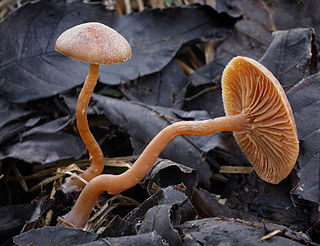
The Tubariaceae is a family of basidiomycete fungi described by Alfredo Vizzini in 2008.

Pluteus americanus is a North American and Russian psychedelic mushroom that grows on hardwoods.

Pluteus exilis is a species of agaric fungus in the family Pluteaceae. It was described as new to science by mycologist Rolf Singer in 1989, from specimens collected in Muir Woods, California.
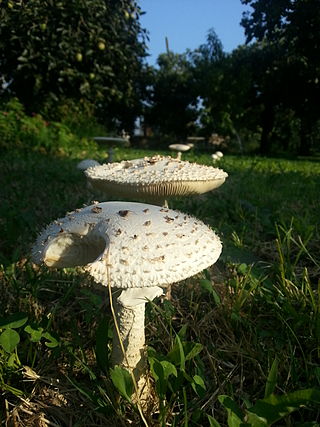
The genus Saproamanita contains about 24 species of agarics and is one of six genera in the family Amanitaceae. The others are Amanita, Catatrama, Limacellopsis, Zhuliangomyces and Limacella. Saproamanita are the saprophytic species in the Tribe Amaniteae, separately classified from the ectomycorrhizal species in the genus Amanita.
















